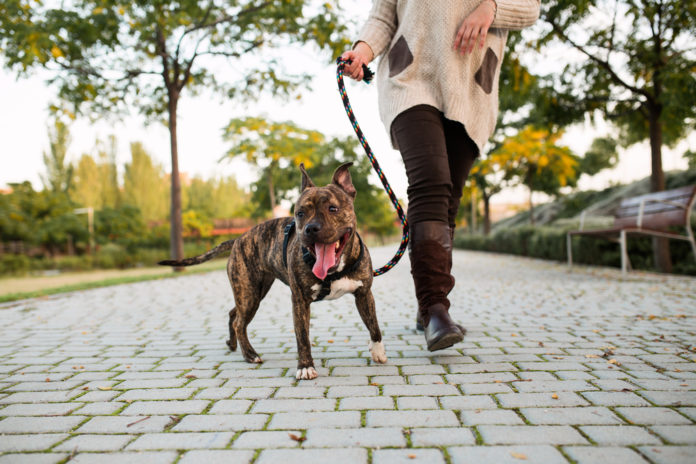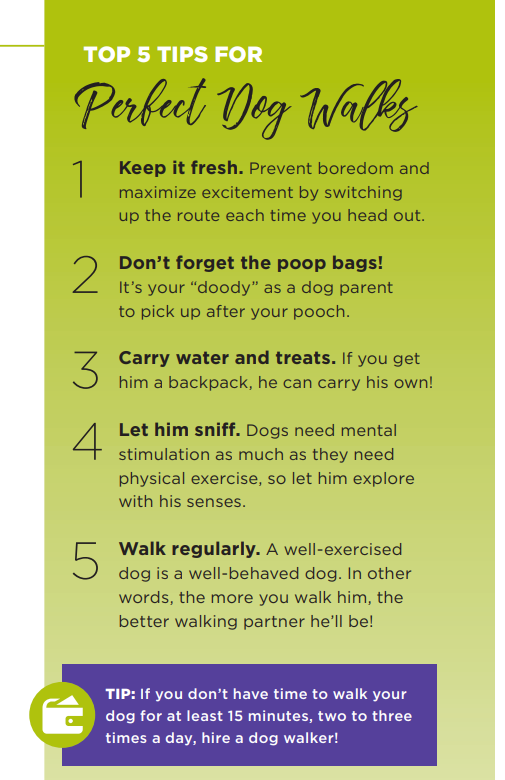The art of dog walking

Dog walking isn’t just a task… it’s an art! Here’s everything you need to buy, do and know to turn your amateur stroll into a brilliant masterpiece.
Ready to take your dog walking skills to the next level? Read on!
The tools
Collars
Traditional – Inexpensive, available in a wide variety of styles, great for everyday use
Martingale – Ideal for dogs who slip out of traditional collars
Harnesses
- Reduce pulling
- Offer more support and security
- Protect the windpipe
Back-clip – Prevents leash from getting tangled between the dog’s legs
Front-clip – Offers maximum control, good for training purposes
Leashes
Traditional – Ideal for everyday walking and basic training
Adjustable – Option for more control during training or on busy streets
Hands-free – Waist loop allows for hands-free walks, great for runners or hikers
Tools to avoid:
- Choke collars
- Prong collars
- Retractable leashes
TIP: Don’t forget identification! Microchip your dog and buy her an engraved ID tag at your local pet store.
The training
“Sit, stay” – Use this basic command when waiting at crosswalks, or if your dog gets taunted by a passing squirrel.
“Heel” – This can take a while to master, but every dog should know how to walk without pulling. Visit animalwellnessmagazine.com/dog-walk-without-pulling for some tips on teaching this behavior.
“Come” – Dogs without good recall skills have no business being off-leash, so make sure she’s well-versed in this command before unclipping her. Even if you don’t plan to let her run free, this is a good skill to work on in case she ever gets loose while you’re out for a walk.
TIP: Train her indoors! You can’t expect a dog to behave on a walk until she’s developed basic manners. Practicing her sitting, heeling and recall skills in a safe space without distractions will set her up for success in the great outdoors.
Safety considerations
Wear reflectors
This is especially important if you’re walking when it’s dark out, or along busy streets
Stick to safe routes
Roads with narrow shoulders and no sidewalks are no place to walk your dog. The same goes for dark alleys, icy paths and remote areas with no cell service. Use common sense when picking a route!
Watch for signs of fatigue or injury
Keep an eye on your pup on walks, especially if he’s a senior or has an existing health condition. Pay extra close attention to his well-being if the weather is extreme.
Be mindful of other dogs
Your dog might be a social butterfly, but not every dog is! Approach strange canines with caution, and always ask their guardians before letting your dog get too close.
Only let her off-leash if she’s trained
No recall, no freedom! Learn how to train the off-leash dog at animalwellnessmagazine.com/training-the-off-leash-dog.
TIP: Know someone with a dog? Ask them if they want to walk together! Not only will this give you some company, it’ll help socialize your dog and introduce you to new walking locales you might not have discovered on your own.

TIP: If you don’t have time to walk your dog for at least 15 minutes, two to three times a day, hire a dog walker!



